Top 10 customer engagement metrics every marketing team should track

Overview
The main focus of the article is to identify the top customer engagement metrics that small businesses should track to enhance their relationships with clients. The article outlines ten key metrics, such as Net Promoter Score (NPS) and Customer Satisfaction Score (CSAT), emphasizing that monitoring these metrics is essential for understanding client needs and improving retention, ultimately leading to increased loyalty and sales.
Introduction
In the competitive landscape of small business, understanding customer engagement metrics is more than just a trend — it’s a necessity. These metrics provide invaluable insights into how effectively a business interacts with its customers, influencing everything from retention rates to overall satisfaction.
With the rise of digital communication and the increasing expectations of consumers, businesses must adapt their strategies to meet these evolving demands. By delving into the nuances of customer engagement, small businesses can identify opportunities for improvement, tailor their offerings, and ultimately foster stronger, more loyal relationships with their clientele.
As the landscape of customer expectations continues to shift, leveraging the right metrics becomes crucial for sustained growth and success.
Understanding customer engagement metrics
Client interaction measures are the lifeblood of any business looking to understand its customers. Think of them as your dashboard — without it, you’re driving blind. These metrics aren’t just numbers; they tell you how well you’re connecting with your clients. You’re looking at client feedback, the frequency of interactions, and overall satisfaction levels. When small business owners dive into these metrics, they’re not just collecting data; they’re uncovering insights that shape their marketing and sales strategies.
Consider this: segmented emails can lead to 30% more opens and 50% more clickthroughs compared to those that aren’t segmented. That’s a game-changer. It underscores the power of targeted communication. Email marketing is still a heavyweight, boasting an average clickthrough rate of 1.40%. And here’s a kicker — 78% of marketers say that subscriber segmentation is the most effective strategy for email campaigns. This isn’t just a trend; it’s a proven method for enhancing engagement.
Metrics like the Net Promoter Score (NPS) and Customer Satisfaction Score (CSAT) are your direct line to consumer sentiment. They provide actionable insights that help businesses make informed decisions. Let’s face it — 48% of consumers expect personalized treatment as ‘good clients.’ If you’re not tailoring your approach based on feedback, you’re missing the mark.
Now, with video advertisement spending set to exceed $191 billion in 2024, the landscape of consumer interaction is evolving. Companies need to adapt or risk being left behind.
Understanding and leveraging customer engagement metrics is not optional; it’s essential. This knowledge is what will help you build lasting client relationships and drive sustained growth. Don’t just collect data — use it to propel your business forward.
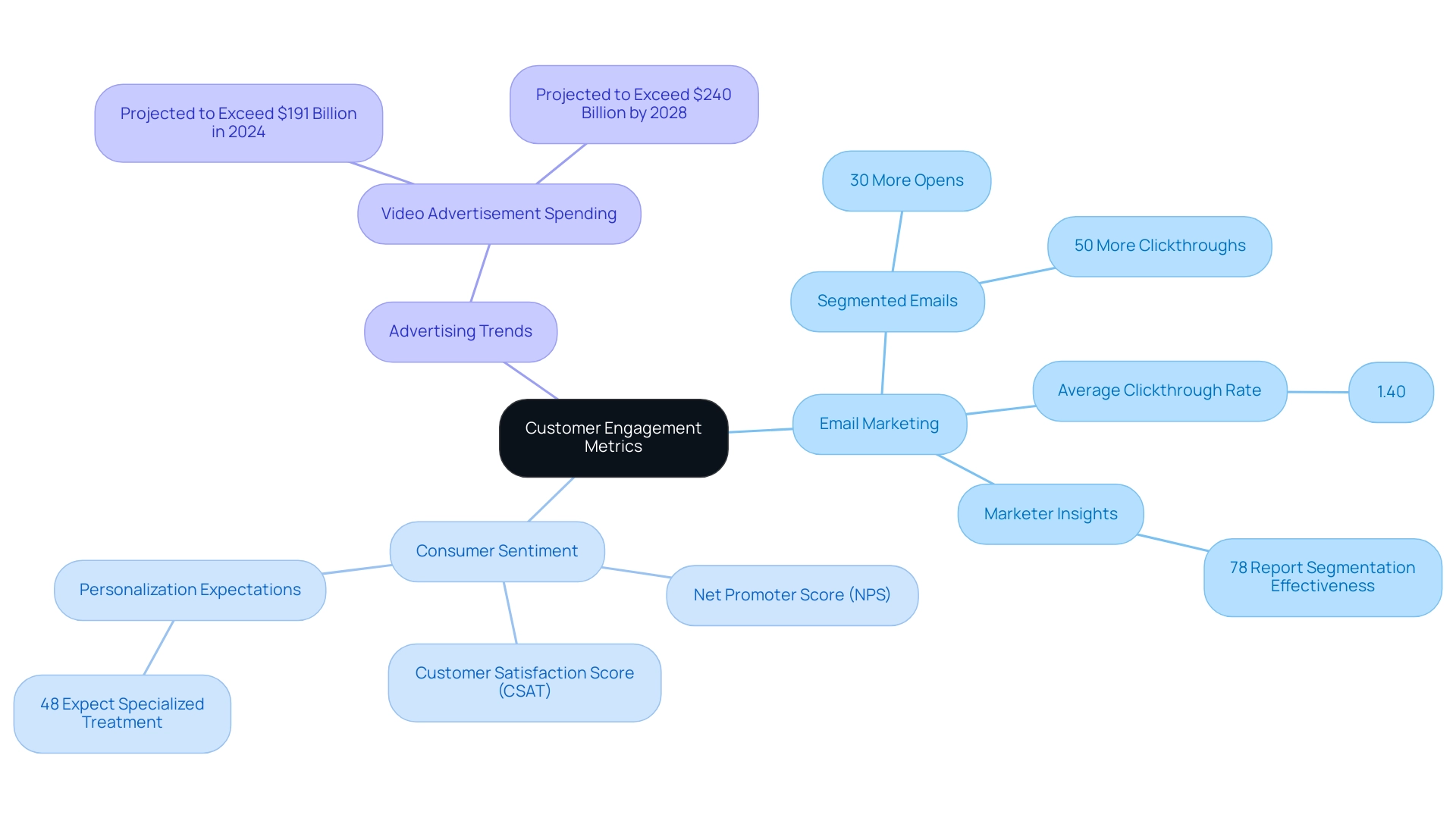
Why tracking customer engagement metrics matters for your marketing strategy
In today’s business world, tracking customer engagement metrics isn’t just a nice-to-have; it’s a must. For marketing teams, these metrics are the lifeblood of client retention and loyalty. Think of it like a ship navigating through fog — without the right instruments, you’re bound to hit something. By analyzing consumer behavior trends, businesses can fine-tune their offerings and communication strategies to meet the ever-evolving needs of their customers. With retention rates for most apps hovering between 6% to 20% within the first eight weeks, understanding these numbers can mean the difference between thriving and merely surviving.
Let’s get real: keeping your existing clients is far cheaper than chasing new ones. When businesses actively monitor engagement metrics, they can spot the warning signs of disengagement before it’s too late. It’s like having a smoke detector in a house — you want to know there’s a fire before it engulfs everything. This proactive approach not only helps in retaining clients but also builds stronger relationships, leading to increased sales and unwavering brand loyalty.
Madhuri Gourav has pointed out that with 55% of support teams expected to work remotely by 2024, companies need to adapt quickly. This is crucial, especially since 44% of organizations aren’t even tracking their customer retention rates (CRR). Ignoring CRR is like sailing without a compass; it severely limits your ability to improve loyalty strategies. If you don’t measure it, you can’t manage it.
Understanding and measuring customer engagement metrics is essential for success in a competitive landscape. Education applications, for instance, have faced retention challenges, largely due to the shift to remote learning. This highlights the need for businesses to adapt their engagement strategies to meet the demands of today’s users. In a world that’s constantly changing, staying ahead means being willing to pivot and adjust.
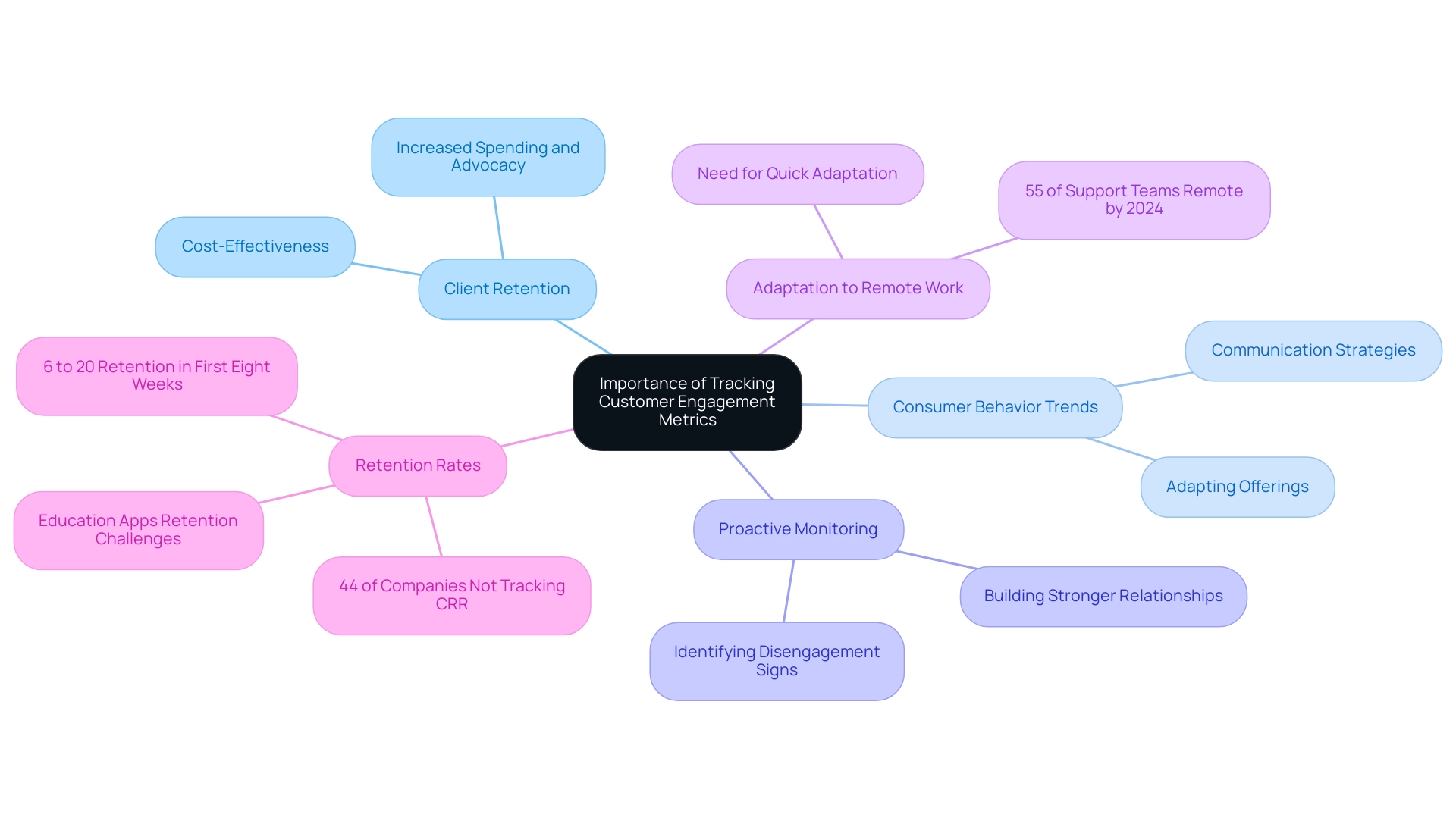
Top 10 customer engagement metrics to monitor
To truly connect with clients, small businesses need to keep a sharp eye on these ten key metrics:
Net Promoter Score (NPS): This is your loyalty thermometer. It tells you how likely your clients are to recommend you. If your score is low, it’s time to dig deep and figure out why.
Client Satisfaction Score (CSAT): This score gives you the pulse on client satisfaction for specific interactions. Think of it as instant feedback on how well you’re serving your clients. Using tools like Dashly can streamline these interactions and boost your engagement metrics.
Client Retention Rate: This one’s all about longevity. It tells you how many clients stick around over time. Research shows you’ve got only a 27% chance of getting a client back after their first purchase. But if they buy a second or third time? That chance jumps to 54%. Retention isn’t just nice to have; it’s crucial. Dashly’s automated follow-ups can help improve these rates.
Client Lifetime Value (CLV): This metric estimates the total revenue you can expect from a client throughout their relationship with you. It’s your guide for how much to invest in acquiring and keeping clients. Dashly’s analytics can provide the insights you need to enhance this value.
Engagement Rate: This measures how actively clients interact with your brand across different channels. If your engagement is low, it’s a sign that your marketing strategies may need a rethink. Dashly’s unified inbox helps you manage all those interactions smoothly.
Churn Rate: This shows the percentage of clients who stop using your product or service. High churn? That’s a red flag. Using Dashly’s self-service options and AI support can help you tackle client issues before they decide to leave.
Social Media Engagement: Keep tabs on likes, shares, comments, and overall interaction on social media. This is crucial for gauging how well your brand resonates with your audience.
Email Open and Click-Through Rates: These metrics tell you how effective your email marketing is. If your messaging isn’t resonating, it’s time to adjust. Dashly’s tools can help optimize these interactions.
Website Traffic and Bounce Rate: Look at how visitors interact with your site. A high bounce rate means people are leaving without engaging. That’s a sign your user experience needs work.
Feedback and Reviews: Gathering client feedback is essential. It’s not just about listening; it’s about acting on what you hear. Dashly’s analytics can help you track and analyze this feedback effectively.
And don’t forget about the referral rate. This measures how many purchases come from referrals, giving you insight into the effectiveness of your referral program.
By focusing on these metrics and leveraging Dashly’s conversational marketing features, including performance analytics and quick response features, small businesses can significantly enhance their client engagement. This leads to greater loyalty and profitability.
Remember, only 34% of participants from firms that don’t prioritize clients felt their organization shared that focus. That’s a wake-up call. If you’re not putting the client experience first, you’re already behind.
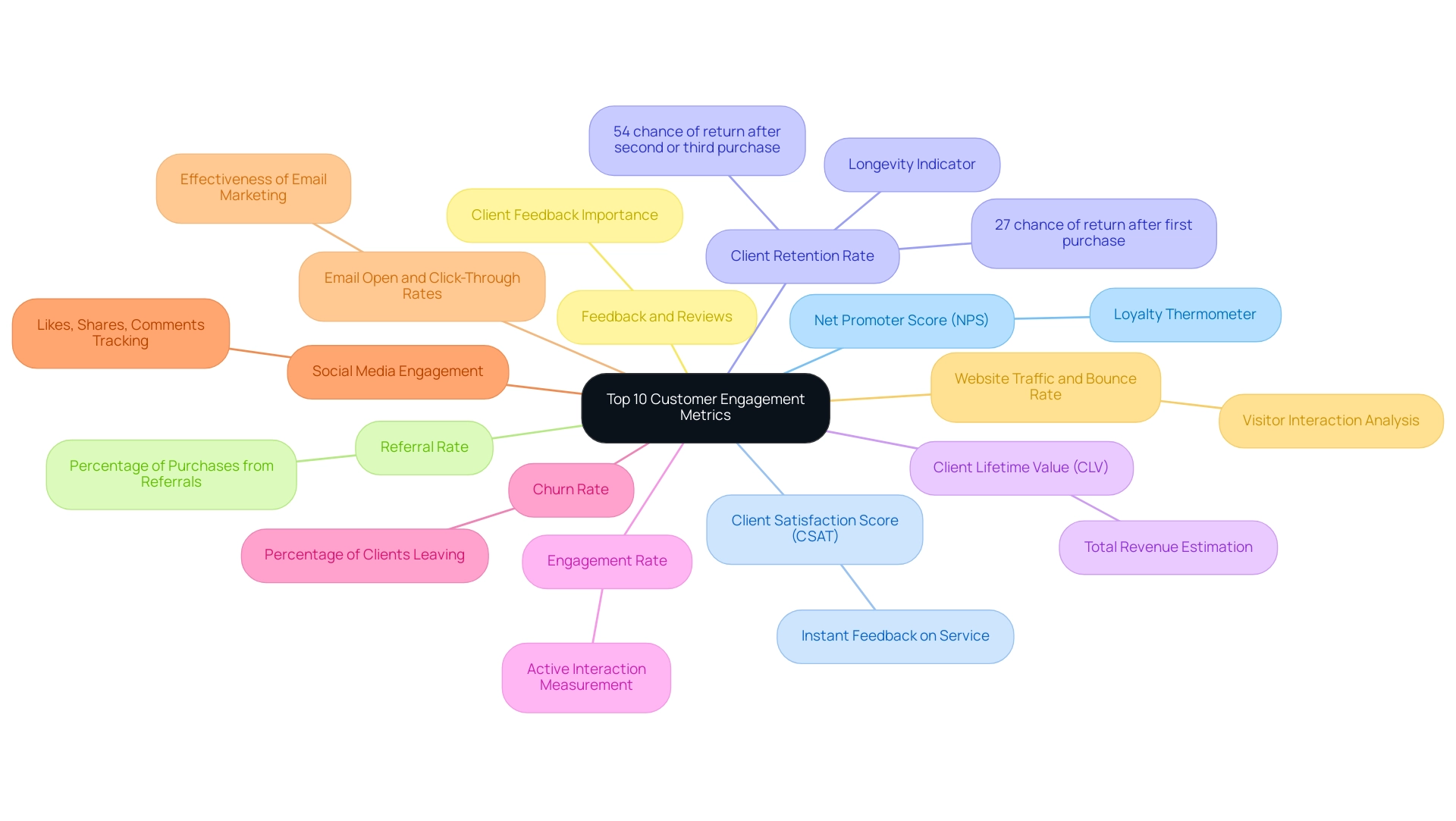
Improve customer engagement with marketing automation from Dashly:
In-depth look at each customer engagement metric
Net Promoter Score (NPS): Think of NPS as your business’s pulse on client loyalty and satisfaction. You ask clients to rate their likelihood of recommending you on a scale from 0 to 10. Anything above zero is a win, but if you hit over 50, you’re in the excellent range. In the internet software and services sector, NPS jumped from 4 in 2023 to 16 in 2024. That’s not just a number; it shows how vital customer engagement is for tracking satisfaction. With Dashly’s omnichannel tools — like a shared inbox that keeps context across conversations — you can boost your NPS. When clients feel valued and understood, they’re more likely to spread the word.
Client Satisfaction Score (CSAT): CSAT is your immediate feedback loop. After an interaction, ask clients to rate their experience on a scale of 1 to 5. A higher score means happier clients. This gives you actionable insights into what’s working and what’s not. Dashly’s saved replies and performance analytics help streamline responses, which can lead to better CSAT scores. Set realistic improvement goals and report on them regularly in meetings. Accountability and progress go hand-in-hand.
Client Retention Rate: This metric is your retention report card. Start with the number of clients at the end of a period, subtract the new clients acquired during that time, and divide by the initial client count. A high retention rate signals that your engagement strategies are working. Dashly automates routine tasks and offers self-service support, letting your team focus on nurturing relationships. That’s how you enhance retention.
Client Lifetime Value (CLV): CLV tells you how much a client is worth over time. Calculate it by multiplying average purchase value, frequency, and lifespan. Understanding CLV helps steer your marketing and sales efforts effectively. With Dashly’s analytics, you can analyze interactions to boost CLV through targeted engagement. It’s about making every client interaction count.
Engagement Rate: Engagement is all about interaction. Monitor likes, shares, and comments against your total followers. This metric reveals how well your content connects with your audience. Dashly’s unified inbox tracks all client interactions, helping you refine your engagement strategy. If your audience is responding, you’re on the right track.
Churn Rate: Churn is a critical metric for understanding client loyalty. Calculate it by dividing the number of clients lost by the total at the start of the period. A lower churn rate means better satisfaction and loyalty. Dashly’s tools help you monitor interactions and provide self-service options, so you can address client needs proactively and keep churn low.
Social Media Interaction: Use analytics to track how your audience interacts with you on social platforms. Focus on engagement relative to your total followers. High interaction rates indicate effective communication. With Dashly’s omnichannel capabilities, your team can engage clients wherever they are, enhancing social media connections.
Email Open and Click-Through Rates: Track how many recipients open your emails and click on links. These metrics are essential for gauging your email campaign’s effectiveness and understanding client interests. By leveraging insights from Dashly’s analytics, you can tailor your email strategies to boost engagement.
Website Traffic and Bounce Rate: Keep an eye on your website traffic using tools like Google Analytics. Look at the number of visitors and the bounce rate — the percentage that leaves without engaging. A high bounce rate might signal issues with content relevance or user experience. Dashly helps improve communication, which can lead to a better user experience and lower bounce rates.
Feedback and Reviews: Regularly collect and analyze client feedback through surveys and reviews. This ongoing dialogue is crucial for identifying improvement areas and shows your commitment to enhancing engagement. Take Heineken, for example. They adopted NPS to strengthen ties with bars and resellers. By using NPS insights, they spotted dissatisfaction trends and managed to grow even during tough times like the COVID-19 pandemic. That’s the power of client feedback. With Dashly, you can harness this feedback effectively to improve support and interaction.
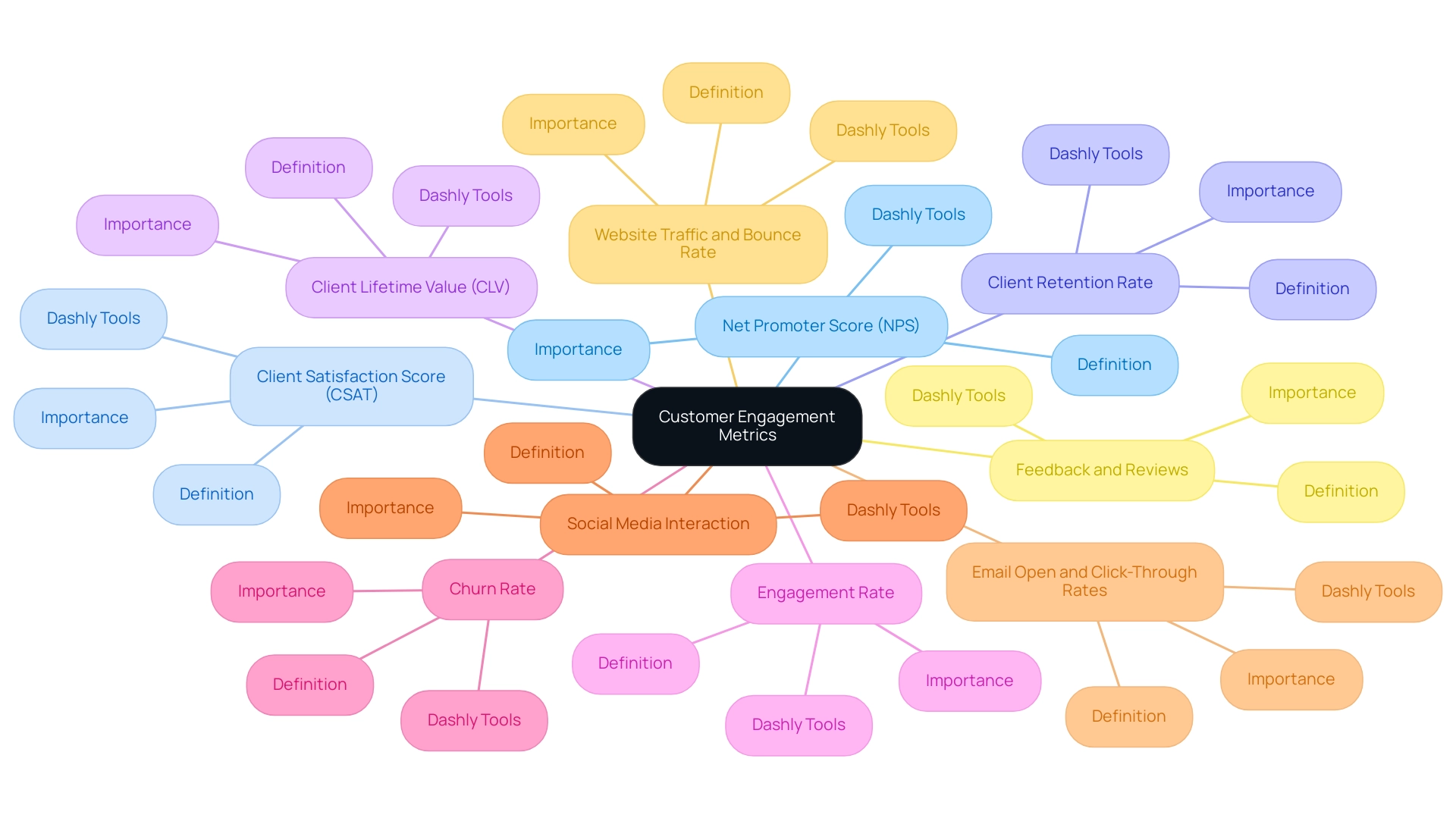
How to implement and track customer engagement metrics
Executing and monitoring client interaction metrics isn’t just a task; it’s a game changer for small businesses. Here’s how to do it right:
Define clear objectives: First off, get specific about what you want to achieve with your engagement metrics. Are you looking to boost satisfaction? Increase retention rates? Having clear goals isn’t just nice to have; it’s essential. Michał Joyce, a Content Specialist at Brand24, puts it well: “Trust me, using them in practice is much easier than it seems at first glance!” That clarity will help you craft strategies that tackle your churn rate head-on. Remember, over 50% of clients will jump ship after just one bad experience. Don’t let that be you.
Choose the right tools: Next, equip yourself with the right tools. Think CRM systems, analytics software, and survey tools to make data collection and analysis a breeze. Take Sprinklr, for example. It’s a robust platform that helps you monitor client feedback and social media interactions all in one place. But be careful — while it offers great insights, you need to weigh its complexity and cost against your budget.
Regularly review metrics: Don’t set it and forget it. Establish a routine for reviewing your engagement metrics — monthly or quarterly works well — to spot trends and make adjustments. This proactive approach is crucial. Address client concerns before they snowball into bigger issues. It’s all about minimizing churn.
Train your team: Your team needs to be on the same page. Make sure they understand the metrics and the tools they have at their disposal. Training isn’t just a checkbox; it’s vital for enhancing interactions and engagement. A well-informed team leads to better client experiences.
Act on insights: Finally, don’t let your data gather dust. Use those insights to drive decisions across your organization. Whether it’s refining marketing strategies or improving client service practices, taking action based on your data can dramatically enhance the client experience.
In short, measuring client interactions isn’t just about numbers; it’s about creating a better experience that keeps clients coming back. Follow these steps, and you’ll be well on your way to turning insights into action.
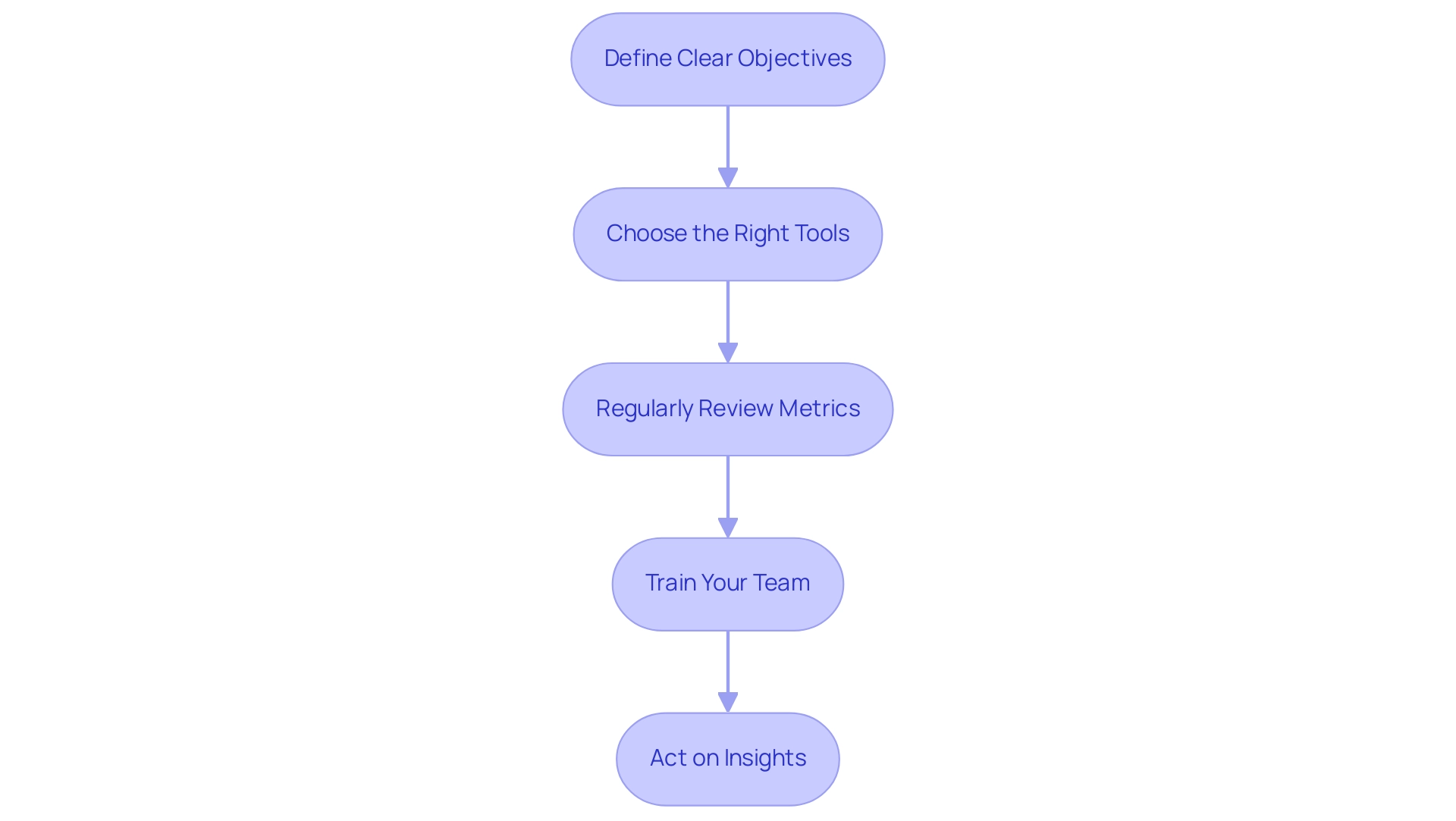
Overcoming challenges in measuring customer engagement
Measuring customer engagement can feel like trying to drink from a fire hose, especially for small businesses. You’ve got a flood of metrics coming at you, and it’s easy to drown in them. Let’s break down the challenges and tackle them head-on.
Data overload: You’ve got more metrics than you know what to do with. It’s like being at an all-you-can-eat buffet and not knowing what to choose.
Solution: Zero in on the key performance indicators (KPIs) that tie directly to your goals. This will help you cut through the noise and focus on what really matters.Lack of resources: Money doesn’t grow on trees, and many small businesses can’t afford fancy analytics tools.
Solution: Look for free or low-cost analytics platforms. They can provide you with essential insights without breaking the bank.Inconsistent data collection: If your data collection methods are all over the place, your results will be too. It’s like trying to put together a puzzle with pieces from different boxes.
Solution: Establish a consistent procedure for collecting and analyzing data from all customer interactions. This will ensure your data is reliable and actionable.Interpreting data: Data can be a foreign language for many small business owners.
Solution: Invest time in training or bring in experts who can help you decode the metrics. This will empower you to make informed decisions.
Now, let’s talk about the stakes. A recent study shows that 48% of consumers who consider themselves ‘good patrons’ expect personalized treatment. If you’re not tracking and responding to customer engagement metrics, you’re missing the mark.
The growth of digital channels is another factor to consider. The number of email users is projected to climb from 4.26 billion in 2022 to 4.73 billion by 2026. That’s a clear signal that you need to sharpen your interaction strategies.
A client-focused approach is not just a nice-to-have; it’s essential. A study titled ‘Impact of Client-Focused Approaches’ found that 67% of people from client-obsessed companies believe their firms are geared toward improving customer engagement metrics. Prioritizing client interaction can lead to better results.
And let’s not overlook the power of video. According to Wyzowl, 92% of video marketers report that video advertising delivers a solid ROI. If you’re not using video to engage your clients, you’re leaving money on the table.
In summary, navigating customer engagement metrics might be tricky, but with the right focus and tools, you can turn challenges into opportunities. Stay sharp, stay focused, and watch your engagement soar.
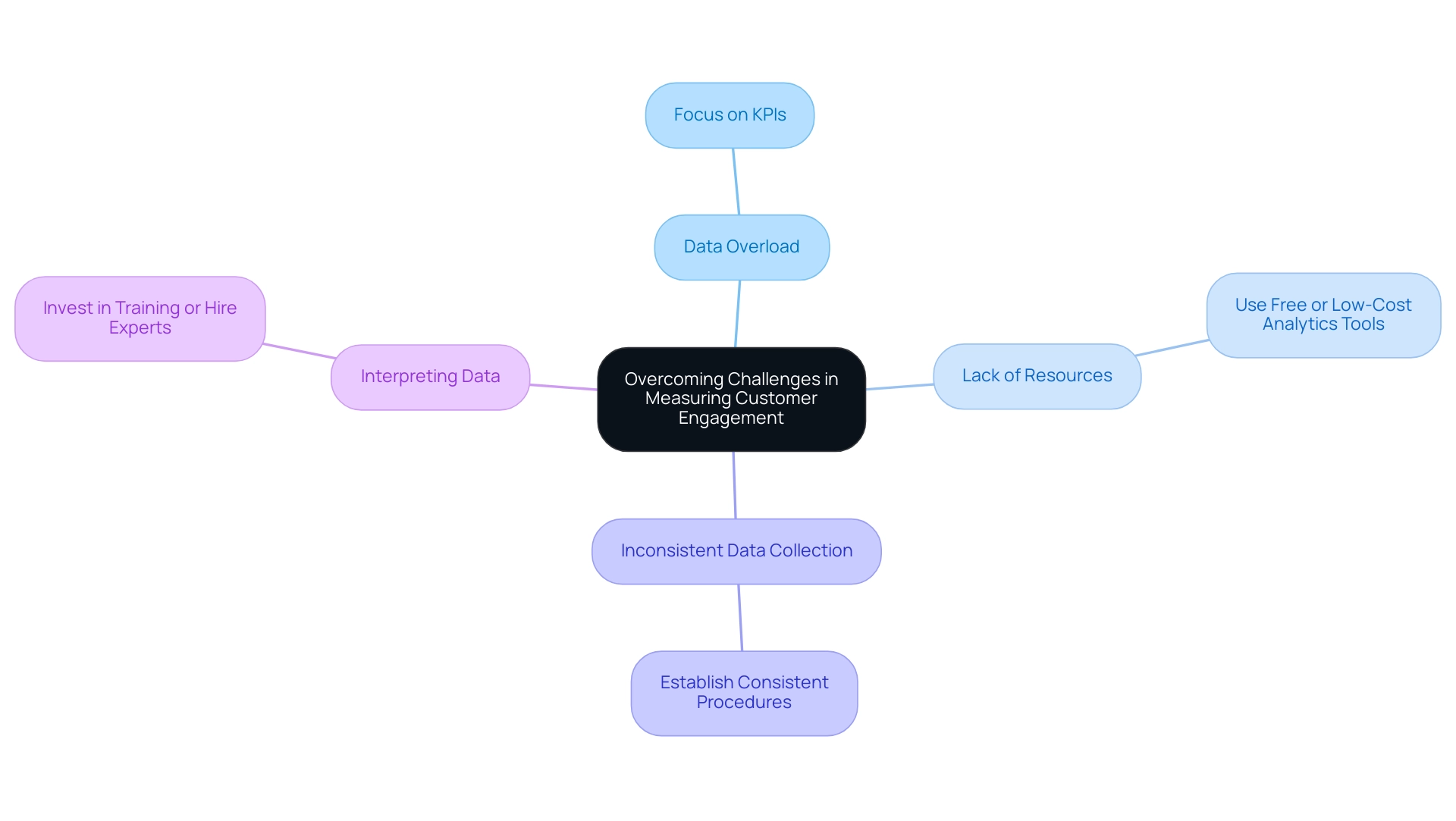
The importance of continuous improvement in customer engagement
In the world of small business, staying competitive means you can’t afford to stand still. Ongoing improvement in how you engage with your customers is not just a nice-to-have; it’s a must. You need to keep a close eye on customer engagement metrics. This isn’t just about numbers; it’s about spotting opportunities to enhance your approach and meet the evolving needs of your clients.
Let’s face it: over half of consumers say that the enjoyment of their experience significantly impacts their buying decisions. That’s a wake-up call. If you’re not prioritizing customer satisfaction, you’re playing a dangerous game. The numbers tell the story — 52% of clients will jump ship if they feel a company isn’t personalizing its communication. If your engagement metrics show a dip, it’s time to take action. It could mean you need to step up your service game or rethink your marketing strategy.
Deloitte’s research drives this point home. A staggering 62% of customer complaints arise from staff attitudes and skills, while only 34% relate to product quality. This highlights a critical area for improvement. By cultivating a culture that values continuous enhancement, small businesses can elevate customer satisfaction and build lasting loyalty.
In an ever-changing market, these strategies aren’t just smart — they’re essential. Adapt, improve, and you’ll not only survive but thrive.
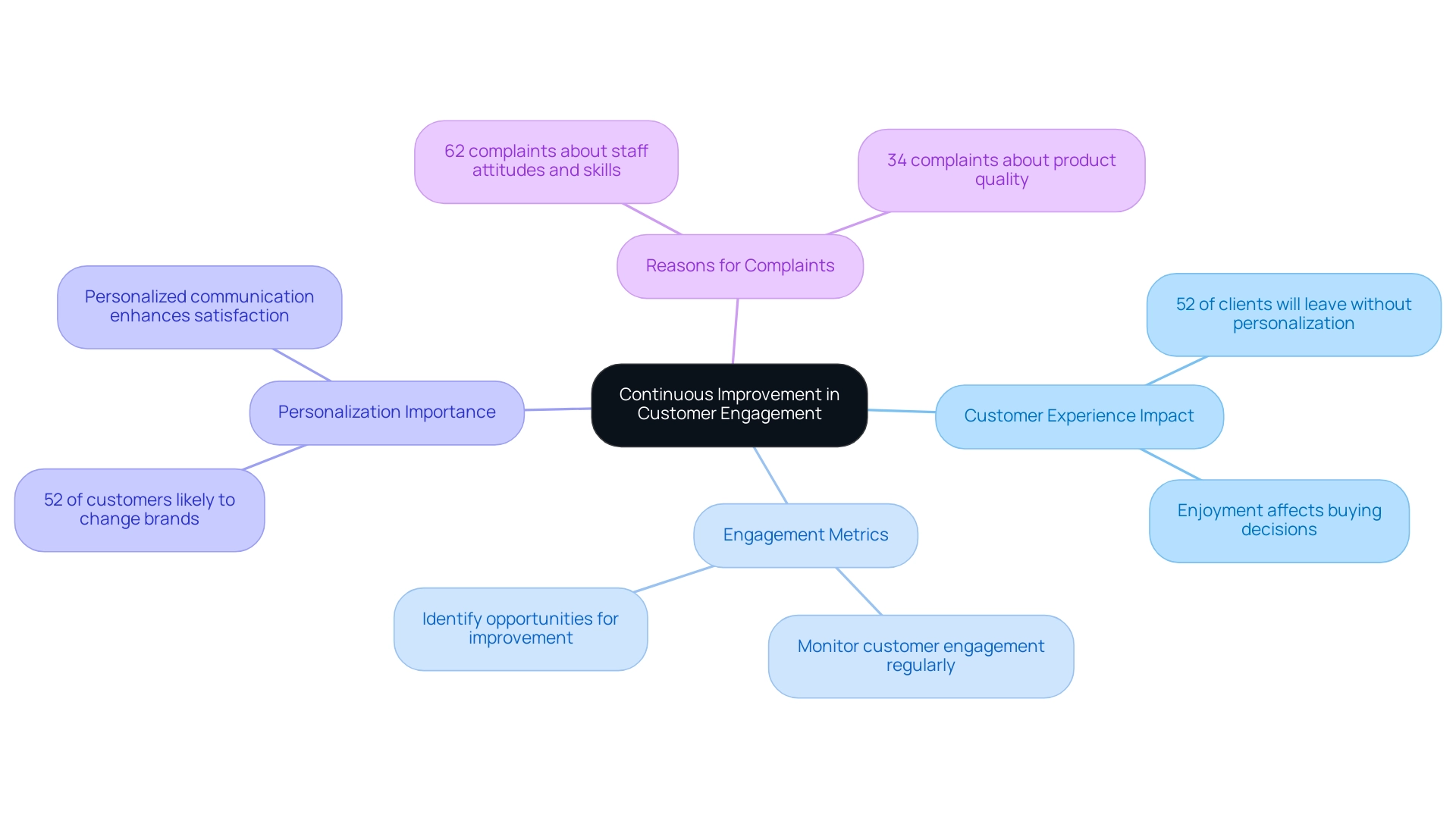
Conclusion
Understanding and effectively leveraging customer engagement metrics is paramount for small businesses striving for success in today’s competitive environment. By closely monitoring these metrics, businesses can gain invaluable insights into customer behavior, preferences, and satisfaction levels, ultimately informing their marketing and sales strategies. The data-driven approach enables small businesses to tailor their offerings, enhance communication, and proactively address customer needs, leading to increased retention and loyalty.
The importance of tracking key metrics such as:
- Net Promoter Score
- Customer Satisfaction Score
- Customer Retention Rate
cannot be overstated. These metrics not only reflect customer sentiments but also guide businesses in recognizing trends and implementing timely interventions. By prioritizing customer-centric strategies and continuously improving engagement practices, small businesses can foster stronger relationships with their clientele, driving growth and profitability.
In a rapidly evolving digital landscape, the ability to adapt and respond to changing customer expectations will set successful businesses apart. Investing in the right tools, training teams, and regularly reviewing engagement metrics are essential steps in this journey. Ultimately, by embracing a culture of continuous improvement and prioritizing customer engagement, small businesses can create a loyal customer base, ensuring sustained success and resilience in the market.





![Sales and Marketing Automation: How to align their workflow to 2x revenue [Dashly example]](https://www.dashly.io/blog/wp-content/uploads/2021/06/IMG_1074-1100x471-1-720x308.jpg)


